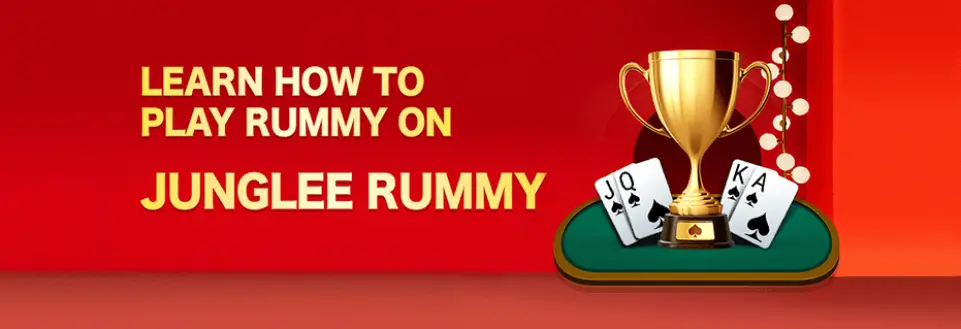How to Play Rummy Online - Detailed Rummy Game Rules
Objective of the Rummy Game
As per rummy rules, the objective of a rummy game is to arrange all the 13 cards dealt to you into sequences and/or sets to form a valid declaration before your opponents do to win the game. The rummy rules state that it is mandatory to create at least two sequences of which one needs to be a pure sequence.
In rummy, the cards are ranked from lowest to highest as follows: Ace, 2, 3, 4, 5, 6, 7, 8, 9, 10, J, Q, K. All face cards (Jack, Queen, King) and Ace (A) are worth 10 points each. The rest of the cards have their number as their points. For example, the 2 of any suit is worth 2 points, the 3 of any suit is worth 3 points, and so on.

When arranging cards, remember that points in rummy are bad because they have a negative value. The goal of the game is to make your score as low as possible, ideally zero in order to win the game and this should be done before the opponents.
How to Play Rummy: Get Started with Rummy Game Rules
Ready to unleash your inner Rummy champion? Let’s take a look at how to play a rummy game from scratch:
- The rules for playing rummy are simple and straightforward. A rummy game is played by 2 to 6 players using a standard deck of 52 cards plus 1 printed joker. The number of decks used in a game depends on number of participants in the gam
- Players take turns drawing and discarding cards to make sequences and sets.
- To play rummy cards, arrange all cards dealt to you in valid sequences and sets and declare your hand first to win.
- Rummy rules make it mandatory to create at least 2 sequences, including at least one pure sequence, for a valid declaration. Making sets is optional but all the remaining cards must be arranged either in sequences or in sets.
- Here are some of the ways to arrange your cards for a valid declaration:
- 2 sequences + 2 sets
- 3 sequences + 1 set
- All cards arranged in sequences.
Tip: Prioritize creating a pure sequence and discard high-value cards early on if they remain ungrouped. If you declare without a pure sequence, the points of all the cards in your hand will be added up to calculate your penalty points.
What is a Sequence?
A sequence is a group of three or more consecutive cards of the same suit. There are two types of sequences: pure sequence and impure sequence.
Pure Sequence
A pure sequence is a group of three or more consecutive cards of the same suit. No card is replaced by a joker in a pure sequence. As per rummy game rules, it is mandatory to make at least one pure sequence for a valid declaration.
Examples of Pure Sequences
Example 1

- It is a pure sequence that consists of three consecutive cards of diamonds. Here no card has been replaced by a joker.
- It is a pure sequence that consists of four consecutive cards of clubs. No card has been replaced by a joker in the sequence.
- In this pure sequence, five consecutive cards from the heart suit are used. No joker is used in this sequence.
A wild joker can also be used in a pure sequence in its original value, but only as a card of its original suit and not to replace any other card. Let us consider the following example: 8❤-9❤-10❤ (WJ).
Example 2
Here 10❤ is also a wild joker, but the sequence is still a pure
sequence because 10❤ has not been used as a joker to replace any other
card in the sequence: it has been used in its original value (10) and
as a card of its original suit (❤).
This strategy is often
useful when you have multiple wild jokers.
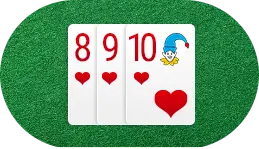
However, when you have limited wild jokers, prefer using them to create impure sequences and sets instead.
Impure Sequence
An impure sequence is a sequence (3 or more cards arranged in a sequence) in which one or more cards have been replaced by a joker or jokers.
Example 1
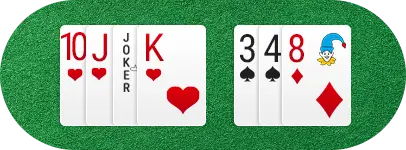
In this impure sequence, the printed joker has been used to replace Q♥.
In this impure sequence, 8♦ is a wild joker. It has been used to replace 5♠.
What is a Set?
Three or four cards of the same rank but different suits form a set. A set cannot have more than one card from any suit. Rummy rules allow you to use one or more jokers to replace any other card(s) in a set.
Without a Joker
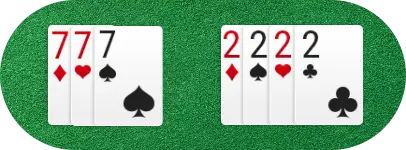
This set has 7s from three different suits.
This set has 2s from four different suits.
With a Joker

In this set, the K♥ is a wild joker.
In this set, the printed joker is optional. If there was no joker, the set would be still complete as it contains all 9s from different suits.
The printed joker has been used to replace the missing cards: Q♥ or Q♠.
In this set, the A♥ is a wild joker.
Invalid Set and Valid Set

As per rummy set rules, this combination does not qualify as a valid set. It is an invalid set as it has two 2♦ cards. If it had 2♥ instead of one 2♦, it would have been a valid set. The correct example of valid set is: 2♦-2♣-2♠-2♥.
Invalid Set and Valid Set

A♣-A♣-K♦ (WJ) This is an invalid set as it includes two A♣ cards. If the combination had either A♦ or A♥ in place of one A♣, it would have been a valid set. The correct examples of valid set are: A♣-A♦-K♦ (WJ), A♣-A♥-K♦ (WJ)
Importance of Jokers in Rummy
One of the most important rummy rules that are taught when you play rummy is how to use jokers. Jokers play a very special role in rummy and can help you win the game. There are two types of jokers used in a game of rummy: printed jokers and wild jokers.
Printed Joker
As the name suggests, a printed joker has the picture of a joker printed on it. This card can be used as a substitute for any missing card and can help you form a set or an impure sequence.
Look at the examples of an impure sequence and a set below to understand how a printed joker can be used in rummy.
Example 1

The printed joker has been used to replace 10♥ in this impure sequence.
The printed joker has been used to replace 2♣ or 2♥ in this set.
Wild Joker
The wild joker is randomly picked at the beginning of the game. When the card is picked, this card along with other cards of the same rank and different suits become the wild joker of the game.
For example, if 4♦ is selected as the wild joker, 4♥, 4♣ and 4♠ will also be the wild jokers of that game.
Just like the printed joker, the wild joker can also be used as a substitute for any missing card and helps form a sequence or a set.
Example 2

In this sequence, the 8♦ is a wild joker. So it’s an impure sequence.
In this set, the 3♣ is a wild joker that has been used to replace 6♣ or 6♦.
A wild joker can be used in a pure sequence too. Examples of pure sequence with a wild joker are as follows:
K♠-Q♠-J♠ (WJ): Here J♠ is the wild joker and it is used to complete the combination which ultimately forms the pure sequence.
4♥-5♥(WJ)-6♥-7♥: Here 5♥ is the wild joker and it connects 4♥, 6♥ and 7♥. The combination created is a pure sequence.
Rummy Rules for Making a Valid Declaration
Valid Declaration
To make a valid declaration, you have to arrange all 13 cards in your hand in sequences, or in sequences and sets. This should be done following all rummy game rules.
After arranging your cards, you have to finish the game by discarding the last unwanted card into the “Finish” slot and declare your hand. The player who makes a valid declaration first wins the game and gets zero points.
For a valid declaration, you need to fulfill the following three conditions:
Pure sequence: Making at least one pure sequence is mandatory to win a rummy game. A pure sequence consists of three or more consecutive cards of the same suit.
Please note that a printed joker cannot be used as a substitute for any card in a pure sequence. However, a wild joker can be used to create a pure sequence as long as it is a part of the suit. Any declaration made without a pure sequence is invalid and the player loses by a margin equal to the total of the values of all the cards in his/her hand.
Second sequence: Rummy rules make it mandatory to make at least two sequences to make a valid declaration in the game. So in addition to a pure sequence, you need to form a second sequence. It can be either a pure sequence or an impure one, depending on the cards you have.
As explained above, an impure sequence includes a joker acting as a substitute for any other card in an impure sequence. You can create more than two sequences too.
All your cards should be arranged: All the remaining cards that are not a part of the two sequences should be arranged in either sequences or sets. Forming a set is optional but all the cards must be a part of a valid combination.
As mentioned above, a set is a combination of three or four cards of the same rank but different suits. Look at an example of a valid declaration below.
Without Wild Joker

It is a pure sequence that has four consecutive cards of the same suit.
This is an impure sequence as a printed joker has been used to replace J♦.
This is a set containing three 2s from different suits.
This is also a set. Here a printed joker has been used to replace 9♣ or 9♦.
With Wild Joker

This is a pure sequence consisting of four consecutive cards. Despite being a wild joker, 8♥ is a part of the suit and completes the combination.
This is a pure sequence with three consecutive face cards of the club suit.
This combination is a set containing three 5s from different suits.
In this combination, a printed joker is used to complete the set. It is used to replace either A♦ or A♥.
Invalid Declaration
When you declare your cards without fulfilling any of the three conditions above, it becomes an invalid declaration. If you make an invalid declaration, you will lose the game instantly and your opponent will be declared the winner if it’s a 2-player table.
If there are more than two players at the table, the other players will keep playing until one of the remaining players makes a valid declaration. Take a look at the examples of some invalid declarations below.
Example 1

This declaration consists of 2 sequences and 2 sets. However, it is still an invalid declaration for the following reasons: 7♠-8♠-9♣-10♠ It is an invalid combination as 9♣ (which is not a wild joker) is used in place of 9♠. If 9♠ was included in the combination, it would have been a pure sequence. The next two combinations, i.e. A♦-2♦-PJ (impure sequence) and 5♠-5♥-5♣ (set), are valid combinations. 3♠-3♥-6♦ It is not a valid combination as 6♦ (which is not a wild joker) is used instead of 3♣ or 3♦.
Example 2

This declaration includes 2 sequences and 2 sets. However, it is still an invalid declaration for the following reasons: A♥-2♥-3♦ It is an invalid combination as it includes 3♦ (which is not a wild joker) in place of 3♥. Including 3♥ instead would have made it a pure sequence. The remaining combinations, i.e. 10♠-J♠-Q♠-K♠ (pure sequence), 6♠-6♥-6♣ (set) and 2♠-2♣-PJ (set), are valid, though.
How Are Points Calculated in a Rummy Game?
Common Rules for Point Calculation
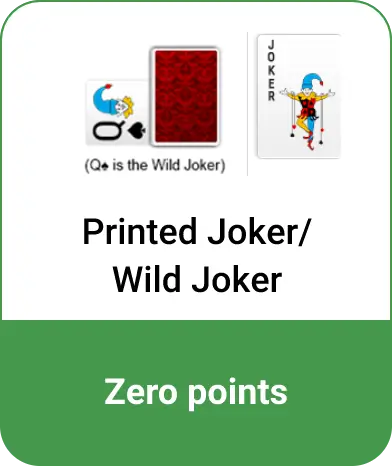
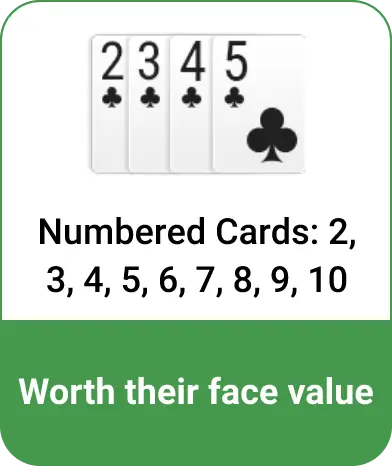

Point Calculation for Losing Players
| Action | Penalty Imposed |
|---|---|
| Invalid declaration (For example, a declaration is made without creating a pure sequence.) | 80 points |
| First drop (When you drop out of the game before picking even your first card.) | 20 points |
| Middle drop (When you drop out of the game any time after picking your first card.) | 40 points |
| 3 consecutive turns missed (When you miss 3 turns in a row, you will be automatically dropped out.) | 40 points |
| Declaring a valid hand second | 2 points |
Point Calculation in Each Rummy Variant
There are three main rummy variants, and each variant offers a unique strategy and pace that caters to different player preferences. Listed below is how winnings are calculated based on each variant’s format and how losing points are accumulated.
Points Rummy
A fast-paced variant where players play for points with a pre-decided cash value per point. The first player to make a valid declaration wins the game instantly.
- No. of Players: 2 to 5
- Maximum Points: 80 points (used for scoring and penalties)
- Winnings: (Sum of points of all opponents) X (Rupee value of the point) – JungleeRummy Fee
- Penalty for losing players: Based on hand value (up to 80 points)
Pool Rummy
Pool Rummy involves players aiming to avoid reaching a set point limit (101 or 201). The game continues until all but one player is eliminated based on these limits.
- No. of Players: 2 to 5
- Maximum Points: 101 or 201 points, depending on the pool type
- Winnings: (Entry Fee x Number of Players) – Junglee Rummy Fee
- Penalty for losing players: 40 points- 101 Rummy, 50 points- 201 Rummy
Deals Rummy
Deals Rummy is played with a fixed number of deals. The player with the highest total points at the end of all deals wins.
- No. of Players: 2 to 5
- Maximum Points: 80 points per deal (depending on losing hand value)
- Winnings: (Entry Fee × Number of Players) – Junglee Rummy Fee
- Penalty for losing players: 20 points (First drop), 40 points (Middle drop), missing three turns consecutively, automatically dropped with 40 points
Important Terms to Know for Understanding Rummy Rules
Here are some important rummy terms you should know to understand how to play rummy game:
Rummy Table: In order to know how to play rummy online, players play the a free practice game at a virtual table. Typically two to six players can play at a rummy table.
Sorting of cards: The sorting of cards is done at the beginning of the game. Simply click on the “Sort” button and your cards will be automatically arranged in combinations according to suit. Sorting is useful to identify potential combinations like pure sequences, impure sequences and sets.
Deal/Round: In rummy, a deal or round begins with the dealing of cards and ends when a player successfully declares his/her hand.
Dealing of cards: At the beginning of rummy game cards are dealt to each player randomly. This process is known as dealing.
Draw and Discard: In a rummy card game, you can draw or pick cards from the closed deck (pile of cards placed face down) or the open deck (pile of cards discarded by players and placed face up).
On each turn, you have to draw a card and discard an unwanted card from your hand. These actions of picking new cards and getting rid of your unwanted cards are known as drawing and discarding, respectively.
Meld: When cards have been dealt, players have to arrange their cards in sequences, or sequences and sets. The act of arranging cards in such valid groups is known as melding.
Printed & Wild Joker: Jokers are essential to a rummy game. There are two types of jokers: printed jokers (1 per deck) and wild jokers (4 per deck). Both types of jokers can be used as substitutes for any missing cards in a set or sequence. They help to form sets and sequences.
A random card is selected as the wild joker at the beginning of the game. The cards of the same rank in all the four suits also become wild jokers.
Drop: You can choose to opt out of the deal/game at any time during the game. This is known as a drop. You get some penalty points for dropping out of a game/deal.
For example, in a points rummy scoring, you get 20 points for dropping out before your very first move in the game and 40 points for dropping out anytime after picking your first card. Dropping before you play your first move is called a first drop, and dropping in the middle of a game is called a middle drop.
Chips: Chips are used to play practice games on Junglee Rummy. You get free chips when you register on Junglee Rummy and you can reload chips when you run out of them.
When you join a practice game, a predefined number of chips will be deducted from your chip balance. When you win, the virtual chips won are credited to your account.
Declare: Immediately after you finish a game by discarding one of your cards to the “Finish” slot, you have to show your cards to your opponents. This is called declaring your hand.
Cash Tournaments: Cash tournaments are tournaments that you join by paying an entry fee. The winners get real money in prizes. On Junglee Rummy, play rummy online, and also participate in cash tournaments every day throughout the year. Just add cash to your Junglee Rummy account and start playing!
To play cash tournaments, download the Junglee Rummy app now. Select the tournament you wish to play & start the game.
Also check Tips and Tricks to Win Rummy Games
How to Play Rummy: FAQs
What is the penalty for rummy?
The penalty for incorrect declaration in rummy is usually the maximum points a player can get in a game, which is often 80 points, indicating a lost game due to the wrong declaration.
Can you discard a joker in rummy?
Yes, you can discard a joker. But unless you have too many jokers and it is preventing you from creating a pure sequence, avoid discarding jokers as they can be used to create both sequences and sets. Also remember that no player can pick a discarded joker from the open deck.
How many points is a joker worth in Indian rummy?
In Indian rummy, the joker is worth zero points. It can be used as a substitute for any missing card in a sequence – thereby creating an impure sequence – or a set. Moreover, if you have ungrouped high-value cards in your hand, you can group the joker with them to make an impure sequence or a set and bring down your total score.
Can we use 2 jokers to create a set in a game of rummy?
Yes, you can utilize more than one joker to create a set in rummy. You can certainly group two jokers with another card to create a set.
How many cards are dealt to a player in rummy?
In every rummy game, 13 cards are dealt to each player. All 13 cards are used to make valid sequences and sets. And whoever makes a valid declaration first wins the game.
What are the rummy rules for a 2-player game?
The rules of rummy remain the same regardless of the number of players playing. The only difference is the number of card decks used. In a 2-player rummy game, only one deck of cards is used. If there are more than 2 players, two card decks are used.
What is the golden rule of rummy?
The golden rule of rummy is to form a pure sequence first, a foundational step towards building a winning hand and minimizing your points in case of a loss.


